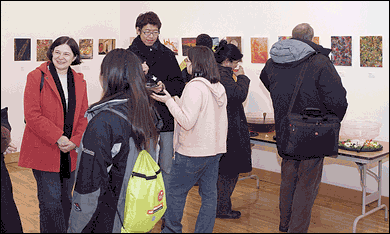|
|
||||||
|
|
Interdisciplinary Course Links Art and Chemistry
"We synthesized our own pigments in the lab, and now we're using the same types of pigments in the studio. It's a really clear association," said art student Samantha Laffey.
Students explored the concept of light as a wave and how light interacts with matter. They studied the electronic structure of atoms and molecules and the concept of chemical reactivity. But they also learned about the artistic and historical use of pigments and how the craft of painting used to be closely linked to the practice of pigment manufacture. Students learned that the distance between chemist and artist increased with the advent of mass-produced and marketed art materials in the nineteenth century. In this new class, chemists and artists came together and used their combined knowledge of the chemical properties of pigments and minerals to create works of art.
"This is a really awesome course. It's fun to use chemistry to be creative," said chemistry student Cara Abbondandolo.
For their final projects, art students teamed up with chemistry students and together they applied their new knowledge of chemistry to create works of art.
Art major Lisa Kaplan and chemistry major Warun Bubna used acid and base chemistry to create colors on a series of four copper plates. They applied acetic acid to the copper plates, which resulted in a chemical reaction that created the green pigment Verdigris. When they spread ammonium hydroxide onto the same copper plates, a deep blue copper ammine complex was produced.
"A variety of colors can be created with compounds containing cobalt," they explained. "These colors depend either on the number of electrons on the cobalt ion or on the atoms bound to cobalt."
The students unveiled their paintings and other works during an exhibition in the University Center gallery in early December.
"I think that all of the students are walking away from this class with a much greater appreciation for the difficulties and pleasures of the other field," said Merrell. "The chemistry students not only got a chance to work in the painting studio for a change, but also got to use their chemistry skills in a more creative and experimental way.
"The art students not only got to spend some time in the lab, using the tools and processes of chemistry, but they also got to learn about their own art materials at a much more fundamental level than they typically would. I learned so much while developing the course, that if any of the students learned half as much as I did, then the class was a great success," Merrell said.
Amy Pavlak |
||||
|
Carnegie Mellon Home |
||||||
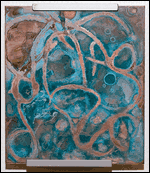
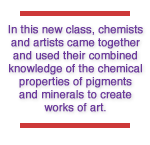 The Color of Minerals and Inorganic Pigments, a joint effort between the Mellon College of Science and the School of Art, was offered for the first time this fall. Catalina Achim, assistant professor of chemistry, and Clayton Merrell, associate professor of art, designed the course to help students use chemistry to create art.
The Color of Minerals and Inorganic Pigments, a joint effort between the Mellon College of Science and the School of Art, was offered for the first time this fall. Catalina Achim, assistant professor of chemistry, and Clayton Merrell, associate professor of art, designed the course to help students use chemistry to create art.
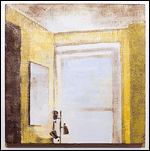
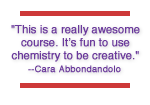 Art major Alexandra Alessi and chemistry major Emmeline Altschul did "Experiments with Cobalt Yellow and Heat" for their final project. First they synthesized a cobalt yellow pigment, also known as aureolin. They mixed the pigment with egg tempera and created a series of four paintings. After painting the aureolin onto the canvas, they heated it to approximately 110°C. The heat caused a chemical transformation of the cobalt pigment, resulting in a color change from yellow to brown/black.
Art major Alexandra Alessi and chemistry major Emmeline Altschul did "Experiments with Cobalt Yellow and Heat" for their final project. First they synthesized a cobalt yellow pigment, also known as aureolin. They mixed the pigment with egg tempera and created a series of four paintings. After painting the aureolin onto the canvas, they heated it to approximately 110°C. The heat caused a chemical transformation of the cobalt pigment, resulting in a color change from yellow to brown/black.
